calsfoundation@cals.org
Eureka Springs (Carroll County)
County Seat
| Latitude and Longitude: | 36º24’04″N 093º44’16″W |
| Elevation: | 1,329 feet |
| Area: | 6.76 square miles (2020 Census) |
| Population: | 2,166 (2020 Census) |
| Incorporation Date: | February 14, 1880 |
Historical Population as per the U.S. Census:
|
1810 |
1820 |
1830 |
1840 |
1850 |
1860 |
1870 |
1880 |
1890 |
1900 |
|
– |
– |
– |
– |
– |
– |
– |
3,984 |
3,706 |
3,572 |
|
1910 |
1920 |
1930 |
1940 |
1950 |
1960 |
1970 |
1980 |
1990 |
2000 |
|
3,228 |
2,429 |
2,276 |
1,770 |
1,958 |
1,437 |
1,670 |
1,989 |
1,900 |
2,278 |
|
2010 |
2020 |
|
|
|
|
|
|
|
|
|
2,073 |
2,166 |
|
|
|
|
|
|
|
Eureka Springs is a northwestern Arkansas tourist town situated in the Ozark Mountains. One of two county seats in Carroll County and home to the legendary healing springs, the city draws a diverse tourist crowd every year and is known for its spas and bathhouses. During the twentieth century, the town attracted an eclectic population, and today it is a mecca for artists, writers, the religious community, and the gay and lesbian community.
Prehistory through Early Statehood
Paleoindians lived in the Eureka Springs area thousands of years ago. During the Woodland and Archaic periods, residents of the area created projectile points (often described as “arrowheads”) from the chert cobbles they found in gravel bars. By the time of the Louisiana Purchase, the Osage tribe living in southern Missouri claimed all of northern Arkansas as its hunting ground. While Osage hunting parties undoubtedly drank from the springs, no evidence exists to suggest that the Osage or other tribes considered the water of any special medicinal value. Accounts of Indian leaders sharing the water with other tribes or with white settlers have been told to visitors since the end of the nineteenth century but have no historical foundation.
When the Osage ceded northern Arkansas to the United States government in 1825, the land was open to white settlers, but the Eureka Springs area remained sparsely populated until after the Civil War. Dr. Alvah Jackson is said to have found the springs (and their reputed healing powers) in 1856, but he reportedly shared the water only locally at first.
Civil War through the Gilded Age
According to local writers, Jackson began marketing the spring water as “Dr. Jackson’s Eye Water.” During the Civil War, it is said, he set up a hospital, “Dr. Jackson’s Cave Hospital,” and healed wounded soldiers with the spring water and other natural remedies he had learned from Native Americans. At the invitation of Jackson in the spring of 1879, Judge Levi Best Saunders of Berryville (Carroll County) tried the spring water for a skin disease, and, after he was healed, he set up camp in the area. Following Saunders’s lead, twenty more families set up camp nearby. Saunders’s son, Buck, reportedly suggested that they call the settlement Eureka for explorer Juan Ponce de Leon’s exclamation—meaning, “I have found it!”—after supposedly finding the Fountain of Youth. In 1880, the “Eureka Springs Baby,” a supposed fossilized child, made headlines, not to be proven false until 1948.
The city was formally founded on July 4, 1879, when Saunders built the first house, and more people arrived every day to take advantage of the springs. O. D. Thornton built the first general store in 1879. Captain Joseph Perry, owner of hotels across the United States, built a four-story hotel, the Perry House, in 1881. Although the city population remained under 4,000 people, thousands more came to the Eureka Springs area and set up housing, often small wooden shacks on the hillsides surrounding the sixty-two springs of the area. The rapid construction of wooden houses—as well as more than fifty hotels, boarding houses, and businesses—made the young community vulnerable to fire, and major fires struck the city in 1883, 1888, 1890, and 1893. Improvements in the city fire department and construction of buildings out of stone rather than wood helped to reduce the danger of fire after those years.
Former Arkansas governor Powell Clayton founded the Eureka Improvement Company to take advantage of the tourism opportunities in the city. The Crescent Hotel, which opened in May 1886, was one property of the Improvement Company. Other major hotels in Eureka Springs included the Hancock House, from 1880 to 1888, and the Perry House, from 1881 to 1890. Both were casualties of major fires in the downtown district of Eureka Springs.
The rapidly growing city was separated from the Carroll County seat in Berryville by the Kings River, which was prone to flooding. As a result, Eureka Springs’ leaders sought to separate the county into two judicial districts with a second courthouse in their city. Though this idea was fought by the citizens of the existing county seat, Berryville, the Arkansas General Assembly approved the proposal on March 12, 1883, effectively making Carroll County one of several counties in Arkansas with two county seats. The courthouse in Eureka Springs was not completed, though, until 1908.
On July 24, 1887, William Morrison was lynched by a mob of his neighbors in Eureka Springs.
When the population and tourism boom began, railroad traffic came via the Frisco line only to Pierce City, Missouri, eighteen miles away. In 1883, the Eureka Springs Railroad was completed, connecting the city to Seligman, Missouri. As many as nine trains a day carried passengers and resources to and from Eureka Springs. In 1900, the line was extended to Harrison (Boone County) and became known as the Missouri and North Arkansas Railroad. After several name changes, the line finally ceased service in 1961.
Early Twentieth Century
On the site of the old Perry House, the Basin Park Hotel went up in 1905. It is still famous today for its unique architecture. Each floor of this eight-story hotel is a ground level because it is built in the side of the mountain. Tourism began to slow as visitors stopped believing in the curative powers of the springs. The railroads moved their shops to Harrison (Boone County), depriving Eureka Springs of many jobs. An expected boom to be prompted by oil wells in northern Arkansas fizzled when little available petroleum was found.
Tourism continued to wane after the turn of the century. The once-famous Crescent Hotel was used as a school, the Crescent College and Conservatory for Young Women, from 1908 to 1924. It operated as a hotel only during the summer. In the 1930s, the building ran as a junior college and even a cancer hospital. However, the cancer hospital, run by quack doctor Norman Baker, was closed after Baker was indicted and convicted for mail fraud in 1940; he had no medical training and his practices were not licensed. During this time, radio evangelist Gerald L. K. Smith moved his operation to Eureka Springs because of its all-white population.
Water from the springs began to be bottled and sent outside the city. Ozarka Brand Natural Spring Water was established in 1905, bottling water from the Basin Spring. When the company first failed, it was purchased by Richard Thompson, a teacher at Crescent College, and he operated it past the middle of the century. He sold the business in 1966 to a California company, and after 1971 the name was acquired by a string of corporations, none of whom actually bottled water from Eureka Springs, or indeed anywhere in the Arkansas Ozarks.
World War II through the Modern Era
After the Depression ended, a number of artists came to Eureka Springs. Louis Freund, an artist with the Works Progress Administration, established a home in the city with his wife, Elsie Freund, in 1939. They started a summer art school, and some of the students stayed in Eureka Springs and opened galleries. The Eureka Springs Gallery Association is made up of nine core galleries, and more than 250 working artists still live and work in Eureka Springs. The city is home to several creative venues for artists: the Eureka Springs School of the Arts, the Writers’ Colony at Dairy Hollow, and the Main Stage Creative Community Center.
Eureka Springs is also known for its religious ties. Religious leader and political extremist Gerald Smith moved to Eureka Springs in 1964. When he came to Eureka Springs after several unsuccessful presidential and senatorial campaigns, he began a series of building projects dubbed the Sacred Projects. On June 25, 1966, he dedicated a seven-story statue of Jesus known as Christ of the Ozarks. The white concrete figure was sculpted by Emmet A. Sullivan and stands atop Magnetic Mountain. Smith also founded the Great Passion Play in 1968, which was the largest outdoor drama in the United States. Both of these attractions are part of a Christian theme park with a Holy Land replica, shopping, an art gallery, restaurants, and a segment of the Berlin Wall.
A community of African Americans had developed in Eureka Springs during the tourism boom. This community had its own schools, as well as a church, associated with the African Methodist Episcopalian denomination. When tourism declined, this community disappeared. Local writers report that the two African-American children known to live in Eureka Springs in the 1940s were denied entrance to the city’s schools. The last known resident of Eureka Springs’ historic black community died in 1975.
Several factors led to the revival of Eureka Springs in the second half of the twentieth century. The construction of Beaver Dam and Beaver Lake in the 1960s drew tourists to the area, as did the establishment of Pea Ridge National Military Park in Benton County in 1956. By the time of the city’s centennial celebration in 1979, downtown Eureka Springs had been revitalized. Empty stores were open for business again, hotels were operating, and newer businesses were being constructed on Highways 62 and 23, which run through the city. The 1988 film Pass the Ammo, a satire of televangelists, was filmed in Eureka Springs.
Eureka Springs also draws a large gay and lesbian community. The Metropolitan Community Church of the Living Springs performs commitment ceremonies for gay and lesbian couples. In 2007, the city council voted to create a registry of domestic partnerships, and in 2010 Eureka Springs became the only city in Arkansas to provide city employee health insurance coverage for domestic partners. Websites for the city promote its atmosphere of tolerance and mutual respect, but groups such as the American Family Association continue to protest the city’s acceptance of the gay and lesbian community. The 2018 documentary The Gospel of Eureka addressed the odd co-existence of both a gay nightlight and attractions for Christian fundamentalists in Eureka Springs.
Attractions
Even though the mystique of the healing waters has faded, Eureka Springs is still a tourist city. It has been called “Little Switzerland” for its mountainous terrain. In 1970, the town’s historic district was listed on the National Register of Historic Places. The Crescent Hotel is famous for its legends of paranormal activity. Thorncrown Chapel, St. Elizabeth’s Catholic Church, the Basin Park Hotel, and Pivot Rock have all been mentioned in the Ripley’s Believe It or Not books. Quigley’s Castle, the Eureka Springs Historical Museum, Opera in the Ozarks at Inspiration Point, the sanctuary of the Turpentine Creek Wildlife Refuge, the Bank of Eureka Springs Museum, and the Ozark Mountain UFO Conference are just a few of many available city attractions. The Tall Pines Motor Inn Historic District, listed on the National Register, continues to provide roadside lodging.
Famous Residents
Early resident Benjamin Rosewater worked with the former governor Powell Clayton in order to lead a movement for civic improvement. Carry Nation, the famous temperance advocate, lived in Eureka Springs near the end of her life, and she gave her last speech there. Likewise, temperance and women’s suffrage activist Lizzie Fyler lived in Eureka Springs. The house she lived in was made into a museum called Hatchet Hall, although it later became a private residence again. Popular ballroom and ragtime dancer Irene Castle lived in Eureka Springs until her death in 1969. Claude Albert Fuller, who had served as mayor of Eureka Springs from 1906 to 1910 and also from 1920 to 1928, represented Arkansas’s Third Congressional District in Washington DC from 1929 to 1939. Poet Glenn Ward Dresbach moved to Eureka Springs and wrote about the Ozarks. Painters Frederick Ernest Swedlun and son Glenn Swedlun were both painters in the area, as was Glenn Rowlett Gant.
For additional information:
Andrew, Scottie. “Inside Eureka Springs, the Bible Belt’s LBGTQ Oasis.” CNN.com, June 29, 2022. https://www.cnn.com/2022/06/29/us/eureka-springs-lgbtq-arkansas-town-cec/index.html (accessed April 13, 2023).
Call, Cora Pinkley. Stair-Step Town: A Background History of the Famous Northwest Arkansas Town That Climbs the Hills. Eureka Springs, AR: Times-Echo Press, 1952.
———. “Stories about the Origin of Eureka Springs.” Arkansas Historical Quarterly 5 (Autumn 1946): 297–307.
Dew, Lee A. “From Trails to Rails in Eureka Springs.” Arkansas Historical Quarterly 41 (Autumn 1982): 203–214.
Eureka Springs City Hall & Municipal Services. https://local.arkansas.gov/local.php?agency=Eureka%20Springs (accessed April 13, 2023).
Froelich, Jacqueline. “Eureka Springs in Black and White: The Lost History of an African-American Neighborhood.” Arkansas Historical Quarterly 56 (Summer 1997): 158–179.
Goh, Robbie B. H. “The Jerusalem of Jesus: Space and Pentecostal-Evangelical Branding in Orlando’s Holy Land Experience and Eureka Springs’ Holy Land Tour.” Culture and Religion 18.3 (2017): 296–323.
Kersen, Thomas. Where Misfits Fit: Counterculture and Influence in the Ozarks. Jackson: University Press of Mississippi, 2021.
Ladwig, Kelli C. “Pope Goes the Weasel: How Greed and a Good Barbecue Hoodwinked a Small Town.” Inquiry: The University of Arkansas Undergraduate Research Journal 22.2 (2023). https://scholarworks.uark.edu/inquiry/vol22/iss2/6/ (accessed January 29, 2024).
Miller, Rachel M. “Our Town: Redefining Cultural Diversity through Community Dynamics in Eureka Springs, Arkansas.” PhD diss., Arkansas State University, 2014.
Schaefer, Susan. I Didn’t Know That!: About Eureka Springs. Eureka Springs, AR: S. Schaefer, 1993.
———. I Didn’t Know That Either!: About Eureka Springs. Eureka Springs, AR: S. Schaefer, 1993.
Westphal, June, and Kate Cooper. Eureka Springs: City of Healing Waters. Charleston, SC: The History Press, 2012.
Zeller, Joyce. The Hidden History of Eureka Springs. Charleston, SC: The History Press, 2011.
Bethany May
Little Rock, Arkansas
Staff of the CALS Encyclopedia of Arkansas
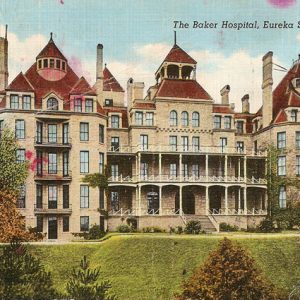 Baker Hospital
Baker Hospital 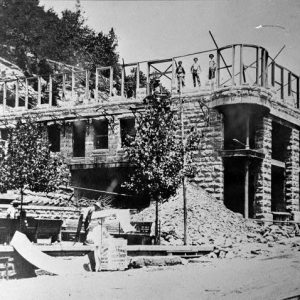 Basin Park Hotel
Basin Park Hotel 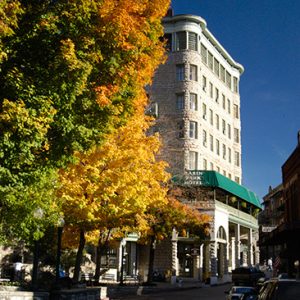 Basin Park Hotel
Basin Park Hotel  Carroll County Courthouse, Western District
Carroll County Courthouse, Western District  Carroll County Map
Carroll County Map  Christ of the Ozarks
Christ of the Ozarks 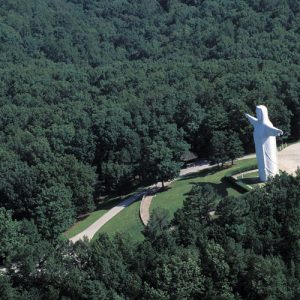 Christ of the Ozarks
Christ of the Ozarks 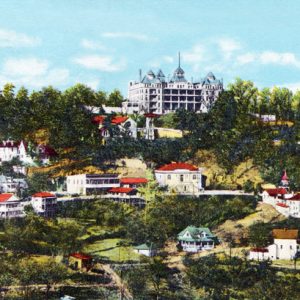 Crescent Hotel
Crescent Hotel 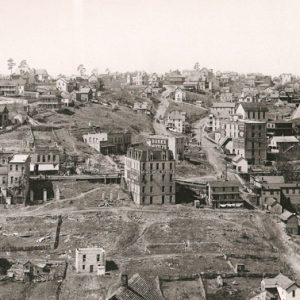 Eureka Springs; 1895
Eureka Springs; 1895 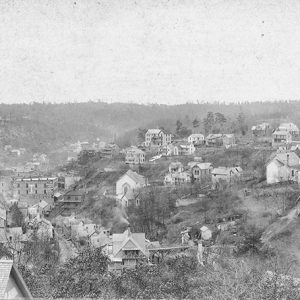 Eureka Springs; 1880s
Eureka Springs; 1880s 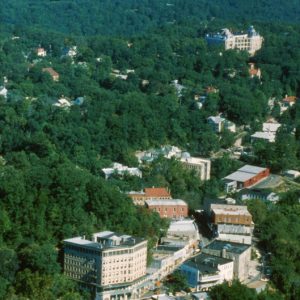 Eureka Springs Aerial View
Eureka Springs Aerial View  Eureka Springs Aerial View
Eureka Springs Aerial View 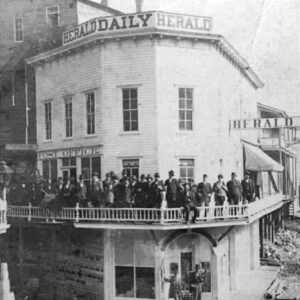 Eureka Springs Businesses
Eureka Springs Businesses 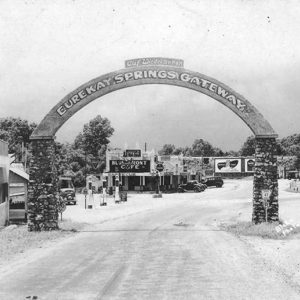 Eureka Springs Gateway
Eureka Springs Gateway 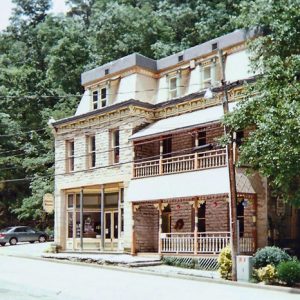 Eureka Springs Historical Museum
Eureka Springs Historical Museum  Eureka Springs Street Scene
Eureka Springs Street Scene  The Gospel of Eureka Poster
The Gospel of Eureka Poster 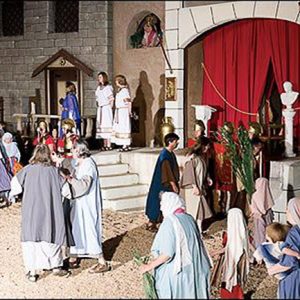 Great Passion Play
Great Passion Play 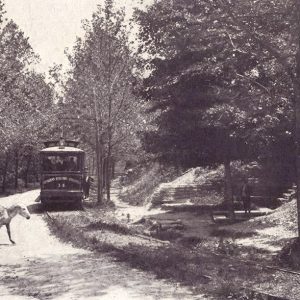 Grotto Springs
Grotto Springs 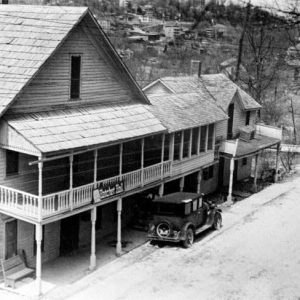 Hatchet Hall
Hatchet Hall  Immaculate Conception Church
Immaculate Conception Church  Kings River
Kings River 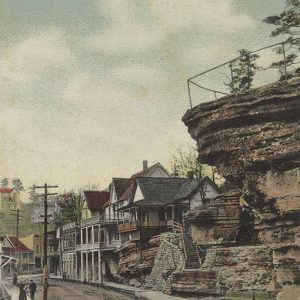 Lover's Leap
Lover's Leap 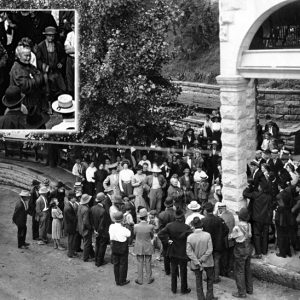 Carrie Nation
Carrie Nation  Pivot Rock
Pivot Rock  Protective Gazebo
Protective Gazebo 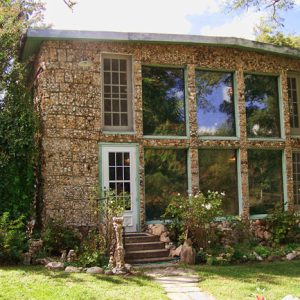 Quigley's Castle
Quigley's Castle  Vance Randolph
Vance Randolph 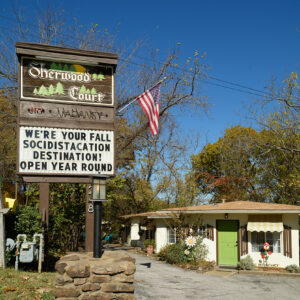 Sherwood Court
Sherwood Court 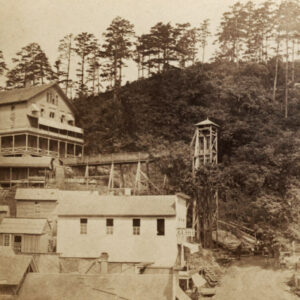 Southern Hotel and Newspaper Office
Southern Hotel and Newspaper Office 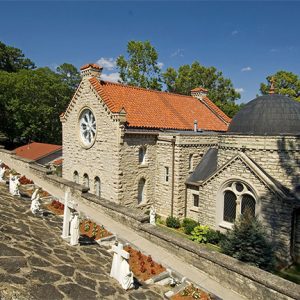 St. Elizabeth's Catholic Church
St. Elizabeth's Catholic Church 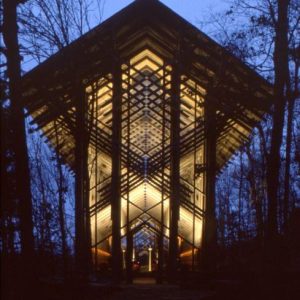 Thorncrown Chapel
Thorncrown Chapel 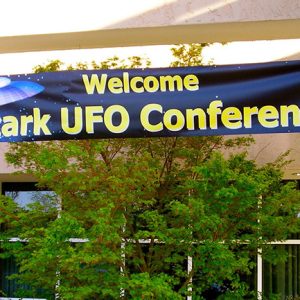 UFO Conference Sign
UFO Conference Sign 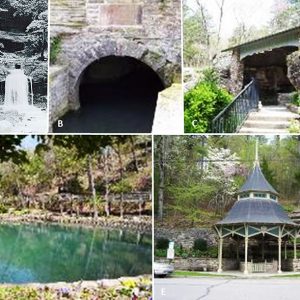 Various Springs
Various Springs 




Eureka Springs, Arkansas, is the final resting place of my second great-grandmother, Susannah Bryan Boren. Susannah Bryan was born April 11, 1763, at Forks of the Yadkin River, Rowan County, North Carolina. She was first cousin of Rebecca Bryan, wife of Daniel Boone. She married Bazel Boren at Boren’s Fort, Washington County, Virginia. Bazel was a long hunter and frequent companion of Daniel Boone in wilderness exploration. He was a hero of the Battle of Kings Mountain in the American Revolution. Bazel and Susannah pioneered Boonesborough and Bryan’s Station, Kentucky; Robertson County, Tennessee; and southern Illinois. When Bazel died in 1812 from wounds received in the Battle of Tippecanoe, Susannah was left with raising her large family. Sometime after 1818, when she is last listed in an Illinois census, she moved with members of her family to Carroll County, Arkansas. She died at Eureka Springs in 1836 at the age of 73. She was one of the earliest pioneers to the region.